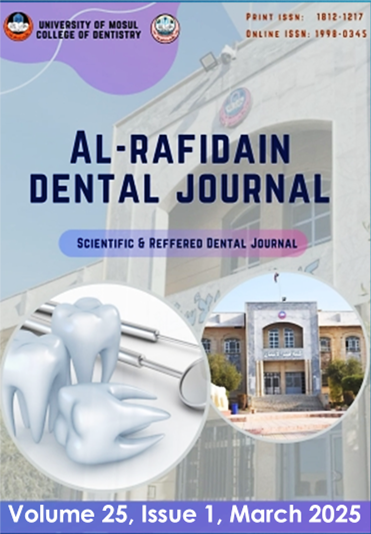Comparison of Surface Roughness of Conventional and Epoxy-coated Stainless Steel Arch Wires in Monocrystalline Ceramic Bracket and Stainless-Steel Bracket
Abstract
Abstract: This study aimed to compare the surface roughness between different combinations of epoxy-coated and stainless-steel arch wires in ceramic and stainless-steel brackets.Materials and methods: Two types of arch wires with a gauge of 0.019x0.025were used in this study: Fantasia non-coated stainless steel arch wire (SSA) (n=18) and tooth tone Epoxy-coated stainless steel arch wires (ECSSA) (n=18). The two types of arch wires were slid on two types of brackets of premolars of slot size 0.022x0.030roth prescription (n=36) divided equally intomonocrystalline sapphire clear aesthetic ceramic brackets (CB) and Razor stainless steel bracket (SSB). The Ra surface roughness was measured using an atomic force microscope AFM to assess the wires before and after sliding them into ceramic and steel brackets. Six samples of wires received from the manufacturer were examined; additionally, six samples from each group of wires were taken after the friction test to examine the changes to the surface of the wires caused by the effect of the frictional force. For the statistical analysis, One-way ANOVA and Pairwise comparisons between groups, using the DUNCAN test at level of significance 0.05, by using SPSS software version 24.Results: ECSSA in CB had the highest value Ra (97 60.1), followed by epoxy wire in steel brackets Ra (96.152.9), followed by epoxy wire as received Ra (79 60.1), followed by steel wire in ceramic bracket Ra (50.6 24.3), followed by steel wire in steel bracket Ra (44.7 23.4), the lowest values shown in steel wire as received Ra (28.213.3). One-way ANOVA showed a significant difference between the tested groups (P=value: 0.05). Duncans test demonstrated significant differences among groups. Conclusion:Epoxy-coated SS arch wire combined with ceramic bracket shows the highest roughness properties, while SS arch wire combined with SS bracket and SS as received shows the lowest roughness properties.
References
- Albuquerque CG, Correr AB, Venezian GC, Santamaria M Jr, Tubel CA, Vedovello SA. Deflection and Flexural Strength Effects on the Roughness of Aesthetic-Coated Orthodontic Wires.Braz Dent J. 2017;28(1):40-45. doi:10.1590/0103-6440201700630.
- Amini F, Rakhshan V, Pousti M, Rahimi H, Shariati M, Aghamohamadi B. Variations in surface roughness of seven orthodontic archwires: an SEM-profilometry study.Korean J Orthod. 2012;42(3):129-137. doi:10.4041/kjod.2012.42.3.129.
- Bandeira AM, dos Santos MP, Pulitini G, Elias CN, da Costa MF. Influence of thermal or chemical degradation on the frictional force of an experimental coated NiTi wire.Angle Orthod. 2011;81(3):484-489. doi:10.2319/042810-232.1.
- Choi S, Hwang EY, Park HK, Park YG. Correlation between frictional force and surface roughness of orthodontic archwires.Scanning. 2015;37(6):399-405. doi:10.1002/sca.21225.
- Choi S, Lee S, Cheong Y, Park KH, Park HK, Park YG. Ultrastructural effect of self-ligating bracket materials on stainless steel and superelastic NiTi wire surfaces.Microsc Res Tech. 2012;75(8):1076-1083. doi:10.1002/jemt.22033.
- Clocheret K, Willems G, Carels C, Celis JP. Dynamic frictional behaviour of orthodontic archwires and brackets.Eur J Orthod. 2004;26(2):163-170. doi:10.1093/ejo/26.2.163.
- D'Ant V, Rongo R, Ametrano G, et al. Evaluation of surface roughness of orthodontic wires by means of atomic force microscopy.Angle Orthod. 2012;82(5):922-928. doi:10.2319/100211-620.1.
- Dokku, A., Peddu, R., Prakash, A. S., Padhmanabhan, J., Kalyani, M., & Devikanth, L. Surface and mechanical properties of different coated orthodontic archwires. J Indian Orthod Soc.(2018) 52(4), 238-242.
- Elayyan F, Silikas N, Bearn D. Ex vivo surface and mechanical properties of coated orthodontic archwires.Eur J Orthod. 2008;30(6):661-667. doi:10.1093/ejo/cjn057
- Gndz G, Korkut S, Korkut DS. The effects of heat treatment on physical and technological properties and surface roughness of Camiyani Black Pine (Pinus nigra Arn. subsp. pallasiana var. pallasiana) wood.Bioresour Technol. 2008;99(7):2275-2280. doi:10.1016/j.biortech.2007.05.015
- Hain M, Dhopatkar A, Rock P. The effect of ligation method on friction in sliding mechanics.Am J Orthod Dentofacial Orthop. 2003;123(4):416-422. doi:10.1067/mod.2003.14.
- Jena, A. K., Duggal, R., & Mehrotra, A. K. (2007). Physical properties and clinical characteristics of ceramic brackets: a comprehensive review.Trends Biomater Artif Organs, (2007).20(2), 101-15.
- Juvvadi SR, Kailasam V, Padmanabhan S, Chitharanjan AB. Physical, mechanical, and flexural properties of 3 orthodontic wires: an in-vitro study.Am J Orthod Dentofacial Orthop. 2010;138(5):623-630. doi:10.1016/j.ajodo.2009.01.032.
- Kakaboura A, Fragouli M, Rahiotis C, Silikas N. Evaluation of surface characteristics of dental composites using profilometry, scanning electron, atomic force microscopy and gloss-meter.J Mater Sci Mater Med. 2007;18(1):155-163. doi:10.1007/s10856-006-0675-8.
- Kim IH, Park HS, Kim YK, Kim KH, Kwon TY. Comparative short-term in vitro analysis of mutans streptococci adhesion on esthetic, nickel-titanium, and stainless-steel arch wires.Angle Orthod. 2014;84(4):680-686. doi:10.2319/061713-456.1.
- Kravitz, N.D. 2013. Aesthetic archwire. Orthodontic product online,1, 20-
- Kusy RP, Whitley JQ, Mayhew MJ, Buckthal JE. Surface roughness of orthodontic archwires via laser spectroscopy.Angle Orthod. 1988;58(1):33-45. doi:10.1043/0003-3219(1988)058<0033:SROOA>2.0.CO;2.
- Kusy RP. Influence on binding of third-order torque to second-order angulation.Am J Orthod Dentofacial Orthop. 2004;125(6):726-732. doi:10.1016/j.ajodo.2003.06.016.
- Lee GJ, Park KH, Park YG, Park HK. A quantitative AFM analysis of nano-scale surface roughness in various orthodontic brackets.Micron. 2010;41(7):775-782. doi:10.1016/j.micron.2010.05.013.
- Lee YK. Colour and translucency of tooth-coloured orthodontic brackets.Eur J Orthod. 2008;30(2):205-210. doi:10.1093/ejo/cjm122.
- Marques IS, Arajo AM, Gurgel JA, Normando D. Debris, roughness and friction of stainless steel archwires following clinical use.Angle Orthod. 2010;80(3):521-527. doi:10.2319/081109-457.1.
- Mihardjanti, M., Nada Ismah, and Miesje Karmiati Purwanegara. "Nickel and chromium ion release from stainless steel bracket on immersion various types of mouthwashes."Journal of Physics: Conference Series. Vol. 884. No. 1. IOP Publishing, 2017.
- Mohan R, Jain RK. An in vitro comparative evaluation of surface roughness characteristics of different orthodontic archwires: An atomic force microscopy study.J Dent Res Dent Clin Dent Prospects. 2022;16(2):91-94. doi:10.34172/joddd.2022.015.
- Muguruma T, Iijima M, Yuasa T, Kawaguchi K, Mizoguchi I. Characterization of the coatings covering esthetic orthodontic archwires and their influence on the bending and frictional properties.Angle Orthod. 2017;87(4):610-617. doi:10.2319/022416-161.1.
- Nanda, R. (Ed.). (1996).Biomechanics in clinical orthodontics. WB Saunders company.).
- Nascimento AC, Muzilli CA, Miranda ME, Flrio FM, Basting RT. Evaluation of roughness and micromorphology of epoxy paint on cobalt-chromium alloy before and after thermal cycling.Braz Oral Res. 2013;27(2):176-182. doi:10.1590/s1806-83242013000100023.
- Proffit, W. R., Fields, H. W., Msd, D. M., Larson, B., & Sarver, D. M. (2019).Contemporary Orthodontics, 6e: South Asia Edition-E-Book. Elsevier India.
- Ramadan AA. Removing hepatitis C virus from polytetrafluoroethylene-coated orthodontic archwires and other dental instruments.East Mediterr Health J. 2003;9(3):274-278.
- Rongo R, Ametrano G, Gloria A, et al. Effects of intraoral aging on surface properties of coated nickel-titanium archwires.Angle Orthod. 2014;84(4):665-672. doi:10.2319/081213-593.1.
- Rudge P, Sherriff M, Bister D. A comparison of roughness parameters and friction coefficients of aesthetic archwires.Eur J Orthod. 2015;37(1):49-55. doi:10.1093/ejo/cju004
- Russell JS. Aesthetic orthodontic brackets.J Orthod. 2005;32(2):146-163. doi:10.1179/146531205225021024.
- Shamohammadi M, Hormozi E, Moradinezhad M, Moradi M, Skini M, Rakhshan V. Surface topography of plain nickel-titanium (NiTi), as-received aesthetic (coated) NiTi, and aesthetic NiTi archwires sterilized by autoclaving or glutaraldehyde immersion: A profilometry/SEM/AFM study.Int Orthod. 2019;17(1):60-72. doi:10.1016/j.ortho.2019.01.016.
- Singh, A.K. (2016) Chapter 4-experimental methodologies for the characterization of nanoparticles. Engineered Nanoparticles: Structure, Properties and Mechanisms of Toxicity, Singh, AK (Ed.).Academic Press, New York, 125-170.
- Waly, G. Do esthetic contradict with function in vitro assessment of load deflection and frictional resisitance of coated versus uncoated superelastic nickel-titanium archwires.Egyptian Dental Journal. (2017) 63(4-October (Fixed Prosthodontics, Dental Materials, Conservative Dentistry & Endodontics)), 3563-3573.
- Wichelhaus A, Geserick M, Hibst R, Sander FG. The effect of surface treatment and clinical use on friction in NiTi orthodontic wires.Dent Mater. 2005;21(10):938-945. doi:10.1016/j.dental.2004.11.011.
- Winchester L. Direct orthodontic bonding to porcelain: an in vitro study.Br J Orthod. 1991;18(4):299-308. doi:10.1179/bjo.18.4.299.
- Yousif, A. A., & Abd El-Karim, U. M.. Microscopic study of surface roughness of four orthodontic arch wires.Tanta Dental Journal. (2016)13(4), 199.
- Zhai, C., Gan, Y., Hanaor, D., Proust, G., & Retraint, D. The role of surface structure in normal contact stiffness.Experimental Mechanics, (2016).56(3), 359-368.












